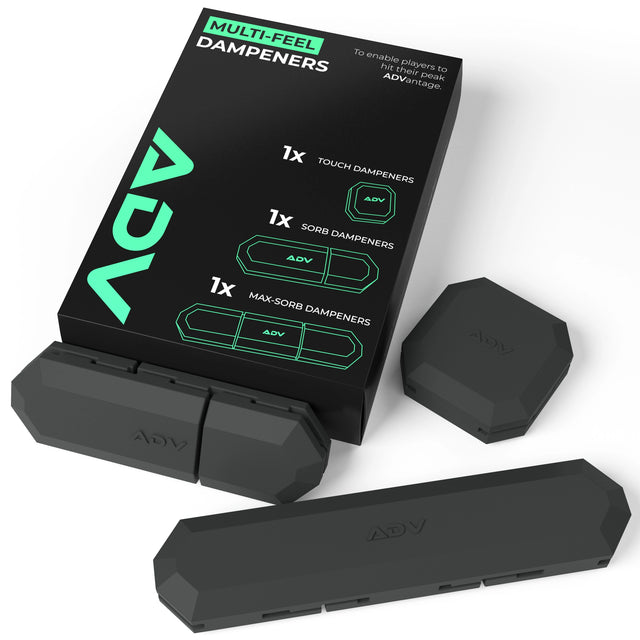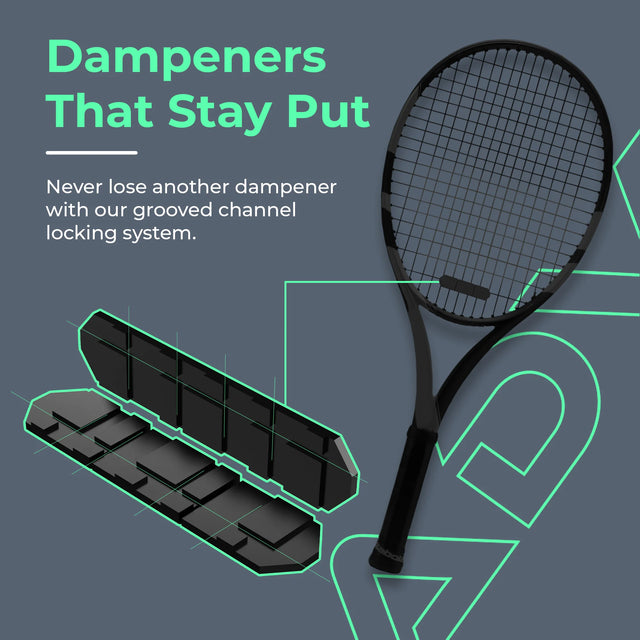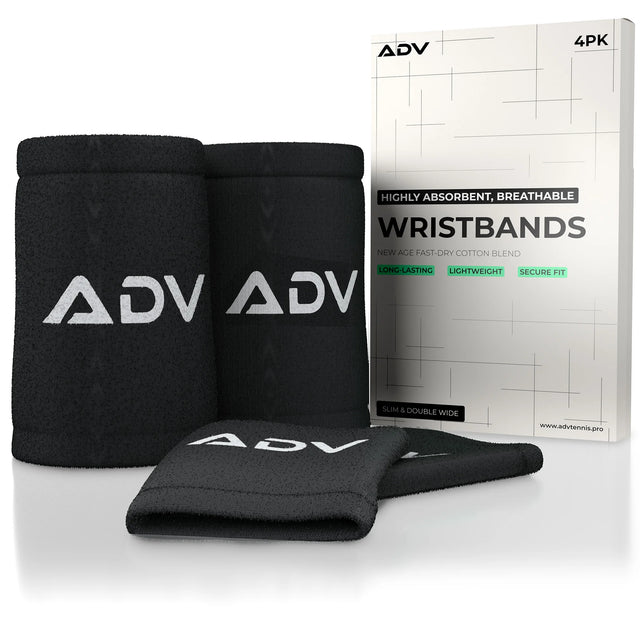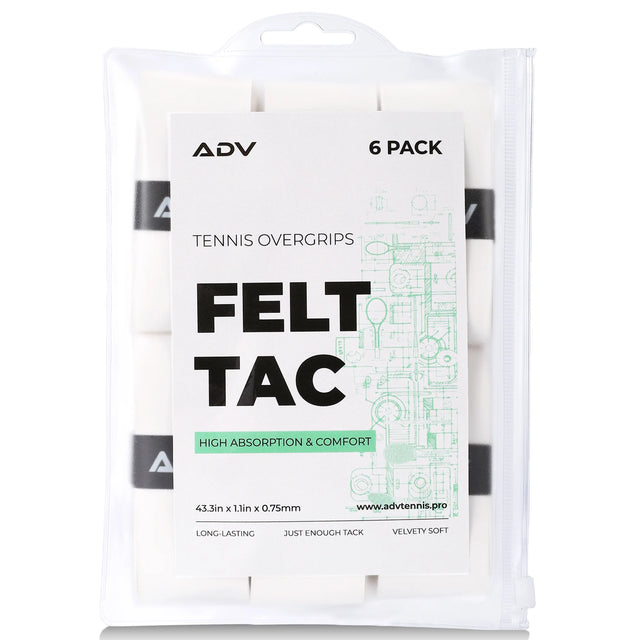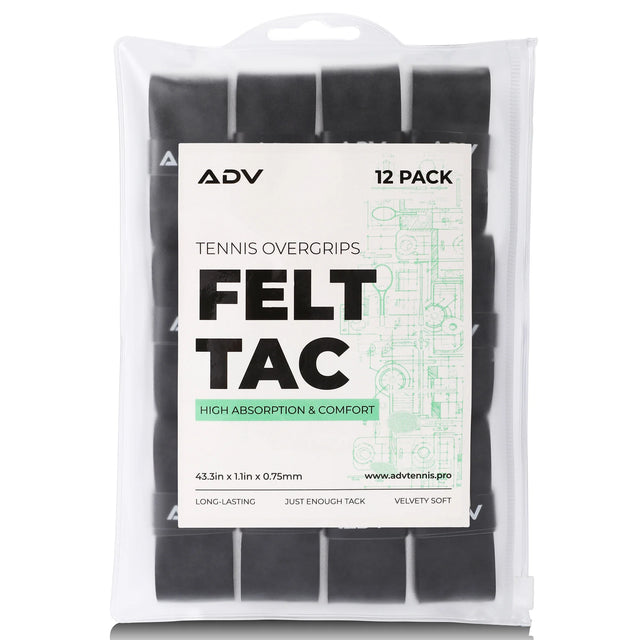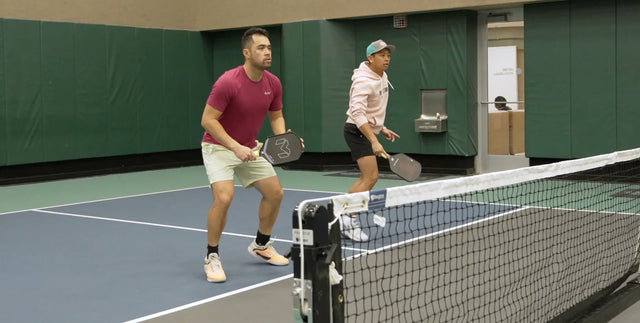Understanding Tennis Grip Sizes: A Guide for Beginners
Selecting the correct racquet grip size is one of the most important steps for new tennis players. A grip size that is too small can lead to excessive wrist movement, increasing the risk of strain or injury, while a grip that is too large may cause difficulty in controlling the racquet. For beginners, having the right grip size ensures better comfort and accuracy when hitting the ball. Additionally, the right tennis racket grip allows players to hold the racquet securely without overexerting their muscles, enabling smoother swings. Understanding these fundamentals helps new players feel more confident in their game and reduces the risk of developing bad habits.
Types of Tennis Grips
Overgrips
It's primarily used to enhance comfort and absorb excess moisture, especially during long matches or hot weather. Overgrips are thin and tacky, offering a fresh feel without significantly increasing the racquet's handle size. They are ideal for players who sweat a lot or those who seek a slight modification in grip thickness for better control. While overgrips don't last as long as replacement grips, they are more affordable and easier to replace, making them a popular choice among all levels of players, particularly beginners who are still finding their comfort zone.
Replacement Grips
This one is used as the first layer directly on the racquet's handle, providing the primary cushioning and texture. Unlike overgrips, replacement grips are thicker and designed to offer more substantial shock absorption and durability. They play a crucial role in a player's comfort and the racquet's overall feel. Opting for a good-quality replacement grip can significantly enhance a player's ability to manage and manipulate the racquet, making it a crucial piece of equipment for any serious player.
Handle Grips
The tennis handle grip forms the foundation of all grips on a racquet. It must provide a secure and stable base for additional grips, like overgrips or specialized tacky grips. The quality of the handle grip affects the overall stability and control a player has over the racquet. Ensuring that your racquet has a robust and durable handle grip is essential for achieving consistent performance. Beginners need to start with a high-quality base grip to learn the correct hand positioning and to develop confidence in their swings.

How to Measure Your Tennis Racquet Grip Size
Using a Ruler to Measure Hand Size
To find the perfect grip size, start by measuring your hand. You can do this easily with a ruler. Place the ruler at the bottom lateral crease of your palm and measure to the tip of your ring finger. This measurement in inches correlates closely to the recommended grip size for your tennis racquet. Most adult grip sizes range from 4 inches to 4 ⅝ inches, allowing you to choose a grip that feels the most natural and comfortable in your hand. This method provides a good starting point for beginners and can help you avoid choosing a grip size that might lead to discomfort or injury.
The Index Finger Test for Grip Fit
Once you have a rough idea of your grip size using a ruler, you can refine your selection with the index finger test. Grip the racquet handle with your usual forehand grip, then slide the index finger of your free hand between the tips of your fingers and the base of your palm on the holding hand. The grip size is right if there's just enough space for your finger to fit snugly. If there's too much room or if your finger cannot fit, you need to adjust the grip size accordingly.
Tools for Measuring Tennis Handle Size
Finding the right racquet grip size is essential for both performance and comfort. Using the correct tools to measure your grip size ensures your racquet fits perfectly, supporting your play style and preventing hand or wrist discomfort. Below is a list of reliable tools to help you accurately identify your ideal grip size:
-
Measuring Tape: A flexible measuring tape offers more precision than a ruler, making it an excellent choice for players seeking a custom fit. Wrap the tape around the widest part of your hand, just below the fingers, to measure the circumference. This circumference can then be matched to grip size charts commonly provided by racquet manufacturers. Using a measuring tape allows for a more detailed understanding of your hand’s dimensions, translating into improved comfort and control on the court. The flexibility of the tape ensures it adapts to the contours of your hand, providing a more tailored measurement.
-
Grip Size Chart: Many tennis shops and racquet manufacturers offer grip size charts to simplify the process. These charts translate your hand’s measurements into specific grip sizes, taking the guesswork out of choosing the right fit. After measuring your hand, compare the results to the chart for a quick and reliable match. This tool is especially helpful for beginners who are unsure about interpreting raw measurements. Grip size charts are also widely available online, making them accessible to players shopping for racquets remotely. Pairing a chart with another measurement method ensures greater confidence in your choice.
-
Digital Calipers: Digital calipers are the gold standard for precise hand measurements. These tools can accurately measure hand width, length, and even finger thickness, ensuring a detailed understanding of your grip needs. Digital calipers are particularly beneficial for serious players or professionals who want to fine-tune their equipment for peak performance. While more commonly used in professional or retail settings, they are an excellent investment for dedicated players.
Players of all skill levels can confidently identify the grip size tips that suit them best using these tools. By combining measurements from multiple tools or cross-referencing results with a chart, you can ensure a precise and comfortable fit. A properly sized grip not only enhances your gameplay but also minimizes the risk of injury, keeping you at your best on the court.
Choosing the Right Grip Size for Comfort and Performance
How Grip Size Affects Control and Power
There are different available grip sizes, their corresponding measurements (in inches or millimeters), and the numbering system commonly used to label them. A smaller grip enables easier wrist snap, facilitating spin and speed, which are crucial for serves and top-spin shots. On the other hand, a larger grip may improve the racquet's stability in your hand, reducing the likelihood of twisting during powerful strokes. This stability is particularly beneficial when playing baseline strokes or when accuracy is paramount. Choosing the right grip size is essential to balance these aspects of tennis play, ensuring that the racquet feels like a natural extension of your arm.

When to Replace Your Grip or Overgrip
- Visible Wear and Tear: Visible damage is one of the most obvious signs that your grip or overgrip needs replacing. Fraying edges, peeling layers, or areas that have become smooth and shiny are clear indicators of wear. These issues reduce the grip’s ability to provide traction, potentially affecting your hold on the racquet during intense rallies or powerful serves. A worn-out grip can also feel rough or uneven, leading to discomfort over time. Regularly inspecting your grip for such signs will ensure that you address these issues before they negatively impact your performance or lead to hand strain.
- Loss of Tackiness or Cushion: Grips and overgrips are designed to provide both a tacky feel for secure handling and cushioning to absorb shock. Over time, these features degrade with use. If your grip feels slick or the cushioning feels compressed and unresponsive, it’s a sign that replacement is due. A loss of tackiness can cause your hand to slip during rapid movements, while reduced cushioning may lead to increased vibration and strain.
- Slippage During Play: A racquet slipping or twisting in your hand during play is a strong indicator that the grip is no longer effective. Slippage reduces precision and control, especially during crucial points in a match. This issue is often exacerbated by sweaty hands or deteriorating grip materials. If you notice frequent adjustments to your hold during a game, it’s time to replace the grip. A fresh grip will restore the stability and confidence you need to focus on your technique rather than your equipment.
- Discomfort or Blistering: New discomfort or the sudden appearance of blisters can indicate that your grip’s surface has become unsuitable. Over time, a worn grip may develop uneven textures or lose its ability to conform comfortably to your hand. This can lead to hotspots or excessive pressure on certain areas of your palm. Replacing the grip prevents further discomfort and helps protect your hands from developing calluses or injuries. Pay attention to how your hands feel during and after matches to identify when a replacement is necessary.
- After a Wet Match: Exposure to moisture, whether from rain or sweat, can rapidly degrade the materials of your comfortable tennis grips. When a grip becomes saturated, it loses its structural integrity and tackiness, making it less effective. If your racquet has been exposed to significant moisture, replacing the grip to avoid slippage and maintain control is wise. Grips designed to wick moisture or with perforated surfaces can mitigate this issue, but they still require replacement after prolonged exposure to wet conditions.
Preventing Tennis Elbow
Tennis elbow, medically known as lateral epicondylitis, is a prevalent condition that arises from overuse of the forearm muscles and tendons, typically affecting athletes who engage in repetitive arm movements, such as tennis players. The condition is characterized by pain and inflammation around the outer part of the elbow, where the tendons attach to the bone. One of the critical factors contributing to this injury is the use of an improperly sized grip on a tennis racket. A grip that is too small forces you to squeeze the handle tighter to maintain control, which overworks the muscles and tendons in the forearm. Conversely, a grip that is too large can strain your forearm because you must overextend to maintain a firm hold on the handle.
Personal Preferences in Grip Comfort
While technical recommendations for grip size are important, personal comfort should not be overlooked. Each player's hand feels different, and what works for one player might not feel right for another. It’s important to try out different sizes to see which one feels the best during play. Many advanced players even fine-tune their grips slightly from the standard sizes to find that perfect fit. Experimenting with different tennis overgrips can also adjust the feel of the grip to better suit personal preferences, ensuring that the grip feels comfortable and enhances your playing style.
Differences in Grip Size Recommendations for Kids, Men, and Women
Grip size recommendations can vary significantly based on age, gender, and playing style, ensuring an optimal fit for every player. Children typically require smaller grip sizes, often ranging from 3 ⅝ to 4 inches, to accommodate their smaller hands and facilitate the development of proper technique. For adult players, men generally use larger grip sizes, with most selecting sizes between 4 ⅜ and 4 ⅝ inches, while women tend to prefer slightly smaller grips, commonly between 4 ⅛ and 4 ⅜ inches. These distinctions are not absolute, as individual hand size and comfort always take precedence, but they provide useful starting points for most players. Additionally, playing style can influence grip size selection: players who rely on powerful baseline shots may benefit from a larger grip for added stability, while those who emphasize topspin and wrist action might opt for a smaller grip to allow greater flexibility and snap. Finding the right grip size is a personal process, but these general guidelines help narrow the options.
Adjusting and Maintaining Your Grip
Options for modifying the grip size of a racquet include adding overgrips to increase the size or using techniques to make the grip smaller.
Layering with Overgrips for Extra Comfort
This practice is particularly useful for players who experience discomfort due to the hardness of standard grips or those who need extra absorption from sweat during play. As mentioned, overgrips are thin and can be applied over the existing grip without drastically altering the size. This method allows for fine adjustments in thickness and tackiness, catering to personal preferences and improving the overall grip experience during long matches.
DIY Methods
Sometimes, the standard grip sizes available do not perfectly match a player’s hand, or a player's preference might change over time. In such cases, do-it-yourself (DIY) methods can adjust the grip size slightly. Adding an underlayer of cushioning tape before applying the tennis replacement grip can increase the diameter of the handle. Alternatively, reducing the number of layers or choosing thinner overgrips can decrease the size. These minor adjustments can make a significant difference in handling comfort and control, allowing players to customize their racquets to their specific needs.
When to Replace Your Grip or Overgrip
Both wear out with use, losing their effectiveness and comfort. Knowing when to replace them is crucial for optimal performance and hand health. Here are some indicators that it might be time to replace:
-
Visible Wear and Tear: Visible damage is one of the most obvious signs that your grip or overgrip needs replacing. Fraying edges, peeling layers, or areas that have become smooth and shiny are clear indicators of wear. These issues reduce the grip’s ability to provide traction, potentially affecting your hold on the racquet during intense rallies or powerful serves. A worn-out grip can also feel rough or uneven, leading to discomfort over time. Regularly inspecting your grip for such signs will ensure that you address these issues before they negatively impact your performance or lead to hand strain.
-
Loss of Tackiness or Cushion: Grips and overgrips are designed to provide both a tacky feel for secure handling and cushioning to absorb shock. Over time, these features degrade with use. If your grip feels slick or the cushioning feels compressed and unresponsive, it’s a sign that replacement is due. A loss of tackiness can cause your hand to slip during rapid movements, while reduced cushioning may lead to increased vibration and strain.
-
Slippage During Play: A racquet slipping or twisting in your hand during play is a strong indicator that the grip has become ineffective. Slippage reduces precision and control, especially during crucial points in a match. This issue is often exacerbated by sweaty hands or deteriorating grip materials. If you notice frequent adjustments to your hold during a game, it’s time to replace the grip. A fresh grip will restore the stability and confidence you need to focus on your technique rather than your equipment.
-
Discomfort or Blistering: New discomfort or the sudden appearance of blisters can indicate that the surface of your grip has become unsuitable. Over time, a worn grip may develop uneven textures or lose its ability to conform comfortably to your hand. This can lead to hotspots or excessive pressure on certain areas of your palm. Replacing the grip prevents further discomfort and helps protect your hands from developing calluses or injuries. Pay attention to how your hands feel during and after matches to identify when a replacement is necessary.
-
After a Wet Match: Exposure to moisture, whether from rain or sweat, can rapidly degrade the materials of your comfortable tennis grips. When a grip becomes saturated, it loses its structural integrity and tackiness, making it less effective. If your racquet has been exposed to significant moisture, replacing the grip to avoid slippage and maintain control is wise. Grips designed to wick moisture or with perforated surfaces can mitigate this issue, but they still require replacement after prolonged exposure to wet conditions.
By staying attentive to these signs, you can enjoy a more comfortable and confident playing experience while prolonging the life of your racquet. A well-maintained grip is a key component of successful tennis matches, so prioritize regular replacements as part of your equipment care routine.
Tips for Maintaining Grip Quality
Store your racquet in a cool, dry place to prevent the grip from becoming brittle or moldy. Clean your grip regularly with mild soap and water to remove dirt and oils that can degrade the material. Avoid leaving your racquet in extreme temperatures, such as in a hot car, as the heat can cause the grip materials to deteriorate faster. Also, rotating between multiple racquets can help reduce the wear and tear on individual grips, keeping them fresher for longer. One must consider recommendations and options for players whose hand size falls between two standard grip sizes, including whether to size up or down, and the use of overgrips or other adjustments.

Where to Buy Quality Tennis Grips and Equipment
Buying Racket Grips and Other Gear
Websites allow you to buy tennis grips online with detailed product descriptions and customer reviews, which can guide you in choosing the best for your needs. For those new to the game, selecting the right racquet is just as crucial as choosing the appropriate grip. Beginner-friendly racquets typically feature larger head sizes for a larger sweet spot, lightweight construction for easier handling, and flexible frames for improved ball control and reduced impact stress on the arm. When exploring options, especially for beginners, it's essential to consider racquets that offer these features to help new players develop their skills comfortably and effectively.
Finding a Reliable Tennis Gear Store
To ensure you buy high-quality and authentic beginner tennis equipment, it’s important to shop at reputable and specialized stores. A reliable tennis gear store will offer a wide range of products from established brands and provide expert advice tailored to your playing level and preferences. Many of these stores also offer services such as racquet stringing and grip replacement, which can be invaluable for maintaining your equipment in optimal condition.
Gaining confidence in selecting the best tennis overgrip involves understanding how different types of grips affect performance and comfort. It also requires learning when to replace worn grips and how to maintain them properly. By educating yourself on the nuances of grip types, sizes, and maintenance techniques, you can make informed choices that enhance your playing experience. This translates into better performance on the court, as you’ll be able to focus more on your game and less on adjusting your grip or dealing with discomfort. Enhance your comfort and confidence on the court, and shop premium tennis grips and gear at ADV Tennis.


